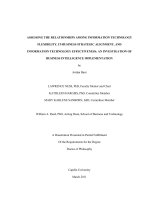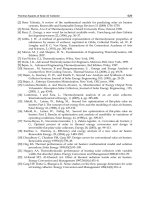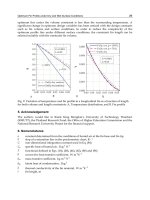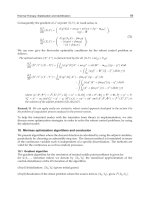communication and information technology
Bạn đang xem bản rút gọn của tài liệu. Xem và tải ngay bản đầy đủ của tài liệu tại đây (676.01 KB, 39 trang )
ninth edition
STEPHEN P. ROBBINS
© 2007 Prentice Hall, Inc.
© 2007 Prentice Hall, Inc.
All rights reserved.
All rights reserved.
PowerPoint Presentation by Charlie Cook
PowerPoint Presentation by Charlie Cook
The University of West Alabama
The University of West Alabama
MARY COULTER
Communication
Communication
and Information
and Information
Technology
Technology
Chapter
Chapter
11
11
© 2007 Prentice Hall, Inc. All rights
reserved.
11–2
L E A R N I N G O U T L I N E
L E A R N I N G O U T L I N E
Follow this Learning Outline as you read and study this chapter.
Follow this Learning Outline as you read and study this chapter.
Understanding Communications
Understanding Communications
•
Differentiate between interpersonal and organizational
Differentiate between interpersonal and organizational
communication.
communication.
•
Discuss the functions of communication.
Discuss the functions of communication.
The Process of Interpersonal Communications
The Process of Interpersonal Communications
•
Explain all the components of the communication process.
Explain all the components of the communication process.
•
List the communication methods managers might use.
List the communication methods managers might use.
•
Describe nonverbal communication and how it takes
Describe nonverbal communication and how it takes
place.
place.
•
Explain the barriers to effective interpersonal
Explain the barriers to effective interpersonal
communication and how to overcome them.
communication and how to overcome them.
© 2007 Prentice Hall, Inc. All rights
reserved.
11–3
L E A R N I N G O U T L I N E (cont’d)
L E A R N I N G O U T L I N E (cont’d)
Follow this Learning Outline as you read and study this chapter.
Follow this Learning Outline as you read and study this chapter.
Organizational Communication
Organizational Communication
•
Explain how communication can flow in an organization.
Explain how communication can flow in an organization.
•
Describe the three common communication networks.
Describe the three common communication networks.
•
Discuss how managers should handle the grapevine.
Discuss how managers should handle the grapevine.
Understanding Information Technology
Understanding Information Technology
•
Describe how technology affects managerial
Describe how technology affects managerial
communication.
communication.
•
Define e-mail, instant messaging, blogs and wikis, voice-
Define e-mail, instant messaging, blogs and wikis, voice-
mail, fax, EDI, teleconferencing, videoconferencing, web
mail, fax, EDI, teleconferencing, videoconferencing, web
conferencing, intranet, and extranet.
conferencing, intranet, and extranet.
•
Explain how information technology affects organizations.
Explain how information technology affects organizations.
© 2007 Prentice Hall, Inc. All rights
reserved.
11–4
L E A R N I N G O U T L I N E (cont’d)
L E A R N I N G O U T L I N E (cont’d)
Follow this Learning Outline as you read and study this chapter.
Follow this Learning Outline as you read and study this chapter.
Communication Issues in Today’s Organization
Communication Issues in Today’s Organization
•
Discuss the challenges of managing communication in an
Discuss the challenges of managing communication in an
Internet world.
Internet world.
•
Explain how organizations can manage knowledge.
Explain how organizations can manage knowledge.
•
Explain why communicating with customers is an
Explain why communicating with customers is an
important managerial issue.
important managerial issue.
•
Explain how political correctness is affecting
Explain how political correctness is affecting
communication.
communication.
© 2007 Prentice Hall, Inc. All rights
reserved.
11–5
What Is Communication?
What Is Communication?
•
Communication
Communication
The transfer and understanding of meaning.
The transfer and understanding of meaning.
Transfer means the message was received in a form that can
Transfer means the message was received in a form that can
be interpreted by the receiver.
be interpreted by the receiver.
Understanding the message is not the same as the receiver
Understanding the message is not the same as the receiver
agreeing with the message.
agreeing with the message.
Interpersonal Communication
Interpersonal Communication
Communication between two or more people
Communication between two or more people
Organizational Communication
Organizational Communication
All the patterns, network, and systems of communications
All the patterns, network, and systems of communications
within an organization
within an organization
© 2007 Prentice Hall, Inc. All rights
reserved.
11–6
Four Functions of Communication
Four Functions of Communication
Functions of
Functions of
Communication
Communication
Functions of
Functions of
Communication
Communication
Control
Control
Control
Control
Motivation
Motivation
Motivation
Motivation
Emotional
Emotional
Expression
Expression
Emotional
Emotional
Expression
Expression
Information
Information
Information
Information
© 2007 Prentice Hall, Inc. All rights
reserved.
11–7
Functions of Communication
Functions of Communication
•
Control
Control
Formal and informal communications act to control
Formal and informal communications act to control
individuals’ behaviors in organizations.
individuals’ behaviors in organizations.
•
Motivation
Motivation
Communications clarify for employees what is to
Communications clarify for employees what is to
done, how well they have done it, and what can be
done, how well they have done it, and what can be
done to improve performance.
done to improve performance.
© 2007 Prentice Hall, Inc. All rights
reserved.
11–8
Functions of Communication (cont’d)
Functions of Communication (cont’d)
•
Emotional Expression
Emotional Expression
Social interaction in the form of work group
Social interaction in the form of work group
communications provides a way for employees to
communications provides a way for employees to
express themselves.
express themselves.
•
Information
Information
Individuals and work groups need information to
Individuals and work groups need information to
make decisions or to do their work.
make decisions or to do their work.
© 2007 Prentice Hall, Inc. All rights
reserved.
11–9
Interpersonal Communication
Interpersonal Communication
•
Message
Message
Source: sender’s intended meaning
Source: sender’s intended meaning
•
Encoding
Encoding
The message converted to symbolic form
The message converted to symbolic form
•
Channel
Channel
The medium through which the message travels
The medium through which the message travels
•
Decoding
Decoding
The receiver’s retranslation of the message
The receiver’s retranslation of the message
•
Noise
Noise
Disturbances that interfere with communications
Disturbances that interfere with communications
© 2007 Prentice Hall, Inc. All rights
reserved.
11–10
Exhibit 11–1
Exhibit 11–1
The Interpersonal Communication Process
The Interpersonal Communication Process
© 2007 Prentice Hall, Inc. All rights
reserved.
11–11
Distortions in Communications
Distortions in Communications
•
Message Encoding
Message Encoding
The effect of the skills, attitudes, and knowledge of
The effect of the skills, attitudes, and knowledge of
the sender on the process of encoding the message
the sender on the process of encoding the message
The social-cultural system of the sender
The social-cultural system of the sender
•
The Message
The Message
Symbols used to convey the message’s meaning
Symbols used to convey the message’s meaning
The content of the message itself
The content of the message itself
The choice of message format
The choice of message format
Noise interfering with the message
Noise interfering with the message
© 2007 Prentice Hall, Inc. All rights
reserved.
11–12
Distortions in Communications (cont’d)
Distortions in Communications (cont’d)
•
The Channel
The Channel
The sender’s choice of the appropriate channel or
The sender’s choice of the appropriate channel or
multiple channels for conveying the message
multiple channels for conveying the message
•
Receiver
Receiver
The effect of skills, attitudes, and knowledge of the
The effect of skills, attitudes, and knowledge of the
receiver on the process of decoding the message
receiver on the process of decoding the message
The social-cultural system of the receiver
The social-cultural system of the receiver
•
Feedback Loop
Feedback Loop
Communication channel distortions affecting the
Communication channel distortions affecting the
return message from receiver to sender
return message from receiver to sender
© 2007 Prentice Hall, Inc. All rights
reserved.
11–13
Interpersonal Communication Methods
Interpersonal Communication Methods
•
Face-to-face
Face-to-face
•
Telephone
Telephone
•
Group meetings
Group meetings
•
Formal presentations
Formal presentations
•
Memos
Memos
•
Traditional Mail
Traditional Mail
•
Fax machines
Fax machines
•
Employee publications
Employee publications
•
Bulletin boards
Bulletin boards
•
Audio- and videotapes
Audio- and videotapes
•
Hotlines
Hotlines
•
•
Computer conferencing
Computer conferencing
•
Voice mail
Voice mail
•
Teleconferences
Teleconferences
•
Videoconferences
Videoconferences
© 2007 Prentice Hall, Inc. All rights
reserved.
11–14
Evaluating Communication Methods
Evaluating Communication Methods
•
Feedback
Feedback
•
Complexity capacity
Complexity capacity
•
Breadth potential
Breadth potential
•
Confidentiality
Confidentiality
•
Encoding ease
Encoding ease
•
Decoding ease
Decoding ease
•
Time-space constraint
Time-space constraint
•
Cost
Cost
•
Interpersonal warmth
Interpersonal warmth
•
Formality
Formality
•
Scanability
Scanability
•
Time consumption
Time consumption
© 2007 Prentice Hall, Inc. All rights
reserved.
11–15
Exhibit 11–2
Exhibit 11–2
Comparison of Communication Methods
Comparison of Communication Methods
Note: Ratings are on a 1–5 scale where 1 = high and 5 = low. Consumption time refers to who
controls the reception of communication. S/R means the sender and receiver share control.
Source: P. G. Clampitt, Communicating for Managerial Effectiveness (Newbury Park, CA: Sage Publications, 1991), p. 136.
© 2007 Prentice Hall, Inc. All rights
reserved.
11–16
Interpersonal Communication (cont’d)
Interpersonal Communication (cont’d)
•
Nonverbal Communication
Nonverbal Communication
Communication that is transmitted without words.
Communication that is transmitted without words.
Sounds
Sounds
with specific meanings or warnings
with specific meanings or warnings
Images
Images
that control or encourage behaviors
that control or encourage behaviors
Situational behaviors
Situational behaviors
that convey meanings
that convey meanings
Clothing and physical surroundings
Clothing and physical surroundings
that imply status
that imply status
Body language:
Body language:
gestures, facial expressions, and
gestures, facial expressions, and
other body movements that convey meaning.
other body movements that convey meaning.
Verbal intonation:
Verbal intonation:
emphasis that a speaker gives to
emphasis that a speaker gives to
certain words or phrases that conveys meaning.
certain words or phrases that conveys meaning.
© 2007 Prentice Hall, Inc. All rights
reserved.
11–17
Interpersonal Communication Barriers
Interpersonal Communication Barriers
Defensiveness
Defensiveness
National
National
Culture
Culture
Emotions
Emotions
Information
Information
Overload
Overload
Interpersonal
Interpersonal
Communication
Communication
Language
Language
Filtering
Filtering
© 2007 Prentice Hall, Inc. All rights
reserved.
11–18
Barriers to Effective Interpersonal
Barriers to Effective Interpersonal
Communication
Communication
•
Filtering
Filtering
The deliberate manipulation of information to make it
The deliberate manipulation of information to make it
appear more favorable to the receiver.
appear more favorable to the receiver.
•
Emotions
Emotions
Disregarding rational and objective thinking
Disregarding rational and objective thinking
processes and substituting emotional judgments
processes and substituting emotional judgments
when interpreting messages.
when interpreting messages.
•
Information Overload
Information Overload
Being confronted with a quantity of information that
Being confronted with a quantity of information that
exceeds an individual’s capacity to process it.
exceeds an individual’s capacity to process it.
© 2007 Prentice Hall, Inc. All rights
reserved.
11–19
Barriers to Effective Interpersonal
Barriers to Effective Interpersonal
Communication (cont’d)
Communication (cont’d)
•
Defensiveness
Defensiveness
When threatened, reacting in a way that reduces the
When threatened, reacting in a way that reduces the
ability to achieve mutual understanding.
ability to achieve mutual understanding.
•
Language
Language
The different meanings of and specialized ways
The different meanings of and specialized ways
(jargon) in which senders use words can cause
(jargon) in which senders use words can cause
receivers to misinterpret their messages.
receivers to misinterpret their messages.
•
National Culture
National Culture
Culture influences the form, formality, openness,
Culture influences the form, formality, openness,
patterns and use of information in communications.
patterns and use of information in communications.
© 2007 Prentice Hall, Inc. All rights
reserved.
11–20
Overcoming the Barriers to Effective
Overcoming the Barriers to Effective
Interpersonal Communications
Interpersonal Communications
•
Use Feedback
Use Feedback
•
Simplify Language
Simplify Language
•
Listen Actively
Listen Actively
•
Constrain Emotions
Constrain Emotions
•
Watch Nonverbal Cues
Watch Nonverbal Cues
© 2007 Prentice Hall, Inc. All rights
reserved.
11–21
Exhibit 11–3
Exhibit 11–3
Active Listening Behaviors
Active Listening Behaviors
Source: Based on P.L. Hunsaker, Training in Management
Skills (Upper Saddle River, NJ: Prentice Hall, 2001).
© 2007 Prentice Hall, Inc. All rights
reserved.
11–22
Types of Organizational Communication
Types of Organizational Communication
•
Formal Communication
Formal Communication
Communication that follows the official chain of
Communication that follows the official chain of
command or is part of the communication required to
command or is part of the communication required to
do one’s job.
do one’s job.
•
Informal Communication
Informal Communication
Communication that is not defined by the
Communication that is not defined by the
organization’s hierarchy.
organization’s hierarchy.
Permits employees to satisfy their need for social interaction.
Permits employees to satisfy their need for social interaction.
Can improve an organization’s performance by creating
Can improve an organization’s performance by creating
faster and more effective channels of communication.
faster and more effective channels of communication.
© 2007 Prentice Hall, Inc. All rights
reserved.
11–23
Communication Flows
Communication Flows
Lateral
Lateral
D
i
a
g
o
n
a
l
D
i
a
g
o
n
a
l
D
D
o
o
w
w
n
n
w
w
a
a
r
r
d
d
U
U
p
p
w
w
a
a
r
r
d
d
© 2007 Prentice Hall, Inc. All rights
reserved.
11–24
Direction of Communication Flow
Direction of Communication Flow
•
Downward
Downward
Communications that flow from managers to
Communications that flow from managers to
employees to inform, direct, coordinate, and evaluate
employees to inform, direct, coordinate, and evaluate
employees.
employees.
•
Upward
Upward
Communications that flow from employees up to
Communications that flow from employees up to
managers to keep them aware of employee needs
managers to keep them aware of employee needs
and how things can be improved to create a climate
and how things can be improved to create a climate
of trust and respect.
of trust and respect.
© 2007 Prentice Hall, Inc. All rights
reserved.
11–25
Direction of Communication Flow
Direction of Communication Flow
(cont’d)
(cont’d)
•
Lateral (Horizontal) Communication
Lateral (Horizontal) Communication
Communication that takes place among employees
Communication that takes place among employees
on the same level in the organization to save time and
on the same level in the organization to save time and
facilitate coordination.
facilitate coordination.
•
Diagonal Communication
Diagonal Communication
Communication that cuts across both work areas and
Communication that cuts across both work areas and
organizational levels in the interest of efficiency and
organizational levels in the interest of efficiency and
speed.
speed.









